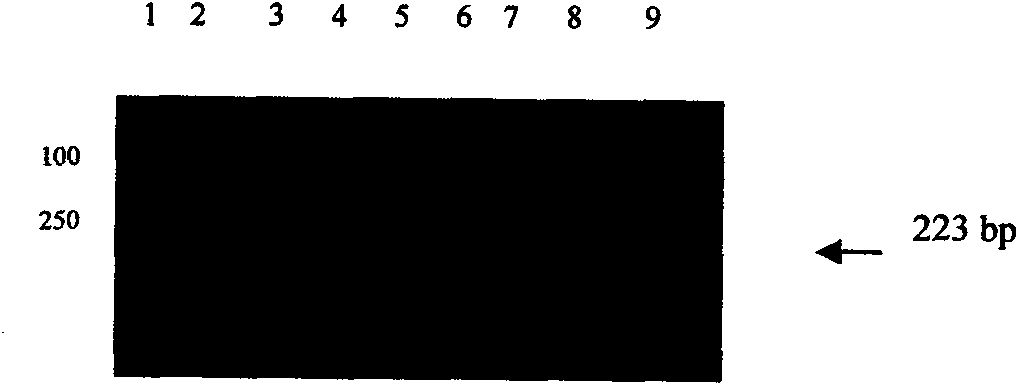Fluorescent quantitative PCR (FQ-PCR) kit for rapidly detecting Toxoplasma gondii
A fluorescence quantification and Toxoplasma gondii technology, which is applied in the direction of fluorescence/phosphorescence, microbe-based methods, microbiological measurement/inspection, etc., can solve the problems of long culture time, PCR pollution, and limited diagnostic value, etc. The effect of good repeatability and fast detection speed
- Summary
- Abstract
- Description
- Claims
- Application Information
AI Technical Summary
Problems solved by technology
Method used
Image
Examples
Embodiment 1
[0035] Embodiment 1: kit composition and preparation
[0036] (1) DNA extraction solution: Prepare lysis buffer, including the following components: 0.1M Tris-HCl (pH8.0), 0.1-0.15M NaCl, 0.1-0.5M EDTA (pH8.0) and 1%-4% SDS. Prepare a stock solution of proteinase K with a concentration of 20 mg / ml. When extracting tissue or cell genome, add proteinase K into the lysis buffer solution, the final concentration is 4ug / ul, which is the DNA extraction solution.
[0037] (2) Fluorescent quantitative PCR reaction solution: prepare reaction solution SYBR-Green I (10×) 0.5 μl, 10× buffer 2.5 μl, dNTP (2.5mmol / L) 2 μl, Taq enzyme (5U / μl) 0.2 μl, MgCl 2 (2.5mmol / L) 3.5μl, forward primer and reverse primer each 1μl (10μmol / L), sterile double distilled water 14.3μl.
[0038] (3) Standard positive template stock solution: the concentration is 10 10 Copy / μl standard positive template pMD-B1.
[0039] (4) Negative charge standard: sterile double distilled water.
Embodiment 2
[0040] Embodiment 2: the specificity test of kit
[0041] Use 1 μl each of 5 control positive samples, including Trichomonas, Giardia, Cryptosporidium parvum, Leishmania, and Eimeria tenena, which have been verified by DNA validity, as templates for fluorescent quantitative PCR reactions, and set a blank control at the same time group and positive control group.
[0042] The PCR amplification conditions were cycle conditions: pre-denaturation at 95°C for 60s; 15s at 95°C, 15s at 58°C, 45s at 72°C, and 40 cycles of amplification.
[0043] The results showed that only Toxoplasma had amplification curves, while Trichomonas, Giardia, Cryptosporidium parvum, Leishmania, and Eimeria tena had no amplification curves. Toxoplasma was repeated three times, and the melting temperature of the melting curve was stable, indicating that the specificity of the PCR amplification product of the target gene was better; the obtained PCR products were subjected to agarose gel electrophoresis, and...
Embodiment 3
[0044] The sensitivity test of embodiment 3 kits
[0045] Firstly, the counted Toxoplasma gondii tachyzoite DNA was diluted to detect its total DNA content, and the double ratio method was used to make 10×, 100×, 1000×, 2000×, 4000×, 8000× diluted Toxoplasma gondii DNA, each 1 μl was The template was subjected to fluorescence quantitative PCR reaction, and a blank control group was set at the same time.
[0046] The PCR amplification conditions were cycle conditions: pre-denaturation at 95°C for 60s; 15s at 95°C, 15s at 58°C, 45s at 72°C, and 40 cycles of amplification.
[0047] The sensitivity of the kit was determined by the experimental results, and the amplification curves of 6 dilutions showed that the fluorescent quantitative PCR kit could detect up to 0.5 Toxoplasma gondii.
PUM
 Login to View More
Login to View More Abstract
Description
Claims
Application Information
 Login to View More
Login to View More - R&D
- Intellectual Property
- Life Sciences
- Materials
- Tech Scout
- Unparalleled Data Quality
- Higher Quality Content
- 60% Fewer Hallucinations
Browse by: Latest US Patents, China's latest patents, Technical Efficacy Thesaurus, Application Domain, Technology Topic, Popular Technical Reports.
© 2025 PatSnap. All rights reserved.Legal|Privacy policy|Modern Slavery Act Transparency Statement|Sitemap|About US| Contact US: help@patsnap.com


